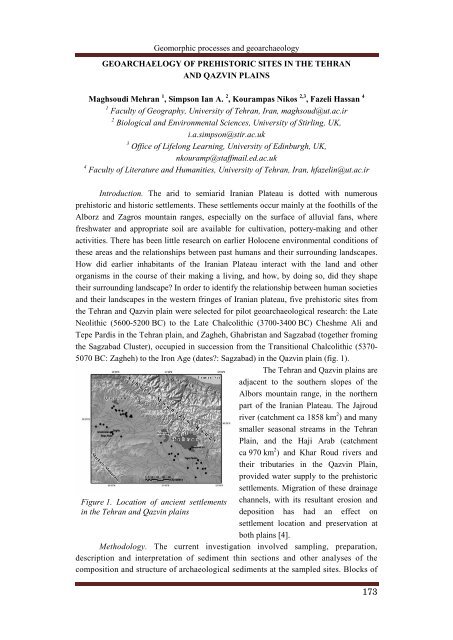extended abstracts - Geomorphic Processes and Geoarchaeology
extended abstracts - Geomorphic Processes and Geoarchaeology
extended abstracts - Geomorphic Processes and Geoarchaeology
You also want an ePaper? Increase the reach of your titles
YUMPU automatically turns print PDFs into web optimized ePapers that Google loves.
<strong>Geomorphic</strong> processes <strong>and</strong> geoarchaeology<br />
GEOARCHAELOGY OF PREHISTORIC SITES IN THE TEHRAN<br />
AND QAZVIN PLAINS<br />
Maghsoudi Mehran 1 , Simpson Ian A. 2 , Kourampas Nikos 2,3 , Fazeli Hassan 4<br />
1<br />
Faculty of Geography, University of Tehran, Iran, maghsoud@ut.ac.ir<br />
2<br />
Biological <strong>and</strong> Environmental Sciences, University of Stirling, UK,<br />
i.a.simpson@stir.ac.uk<br />
3<br />
Office of Lifelong Learning, University of Edinburgh, UK,<br />
nkouramp@staffmail.ed.ac.uk<br />
4<br />
Faculty of Literature <strong>and</strong> Humanities, University of Tehran, Iran, hfazelin@ut.ac.ir<br />
Introduction. The arid to semiarid Iranian Plateau is dotted with numerous<br />
prehistoric <strong>and</strong> historic settlements. These settlements occur mainly at the foothills of the<br />
Alborz <strong>and</strong> Zagros mountain ranges, especially on the surface of alluvial fans, where<br />
freshwater <strong>and</strong> appropriate soil are available for cultivation, pottery-making <strong>and</strong> other<br />
activities. There has been little research on earlier Holocene environmental conditions of<br />
these areas <strong>and</strong> the relationships between past humans <strong>and</strong> their surrounding l<strong>and</strong>scapes.<br />
How did earlier inhabitants of the Iranian Plateau interact with the l<strong>and</strong> <strong>and</strong> other<br />
organisms in the course of their making a living, <strong>and</strong> how, by doing so, did they shape<br />
their surrounding l<strong>and</strong>scape? In order to identify the relationship between human societies<br />
<strong>and</strong> their l<strong>and</strong>scapes in the western fringes of Iranian plateau, five prehistoric sites from<br />
the Tehran <strong>and</strong> Qazvin plain were selected for pilot geoarchaeological research: the Late<br />
Neolithic (5600-5200 BC) to the Late Chalcolithic (3700-3400 BC) Cheshme Ali <strong>and</strong><br />
Tepe Pardis in the Tehran plain, <strong>and</strong> Zagheh, Ghabristan <strong>and</strong> Sagzabad (together froming<br />
the Sagzabad Cluster), occupied in succession from the Transitional Chalcolithic (5370-<br />
5070 BC: Zagheh) to the Iron Age (dates?: Sagzabad) in the Qazvin plain (fig. 1).<br />
The Tehran <strong>and</strong> Qazvin plains are<br />
adjacent to the southern slopes of the<br />
Albors mountain range, in the northern<br />
part of the Iranian Plateau. The Jajroud<br />
river (catchment ca 1858 km<br />
Figure 1. Location of ancient settlements<br />
in the Tehran <strong>and</strong> Qazvin plains<br />
2 ) <strong>and</strong> many<br />
smaller seasonal streams in the Tehran<br />
Plain, <strong>and</strong> the Haji Arab (catchment<br />
ca 970 km 2 ) <strong>and</strong> Khar Roud rivers <strong>and</strong><br />
their tributaries in the Qazvin Plain,<br />
provided water supply to the prehistoric<br />
settlements. Migration of these drainage<br />
channels, with its resultant erosion <strong>and</strong><br />
deposition has had an effect on<br />
settlement location <strong>and</strong> preservation at<br />
both plains [4].<br />
Methodology. The current investigation involved sampling, preparation,<br />
description <strong>and</strong> interpretation of sediment thin sections <strong>and</strong> other analyses of the<br />
composition <strong>and</strong> structure of archaeological sediments at the sampled sites. Blocks of<br />
173


